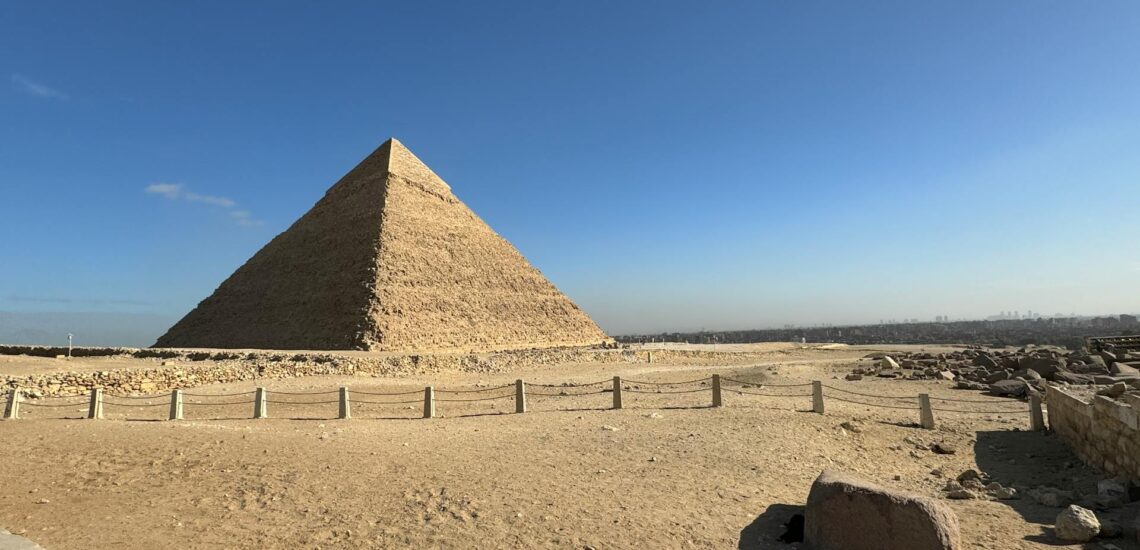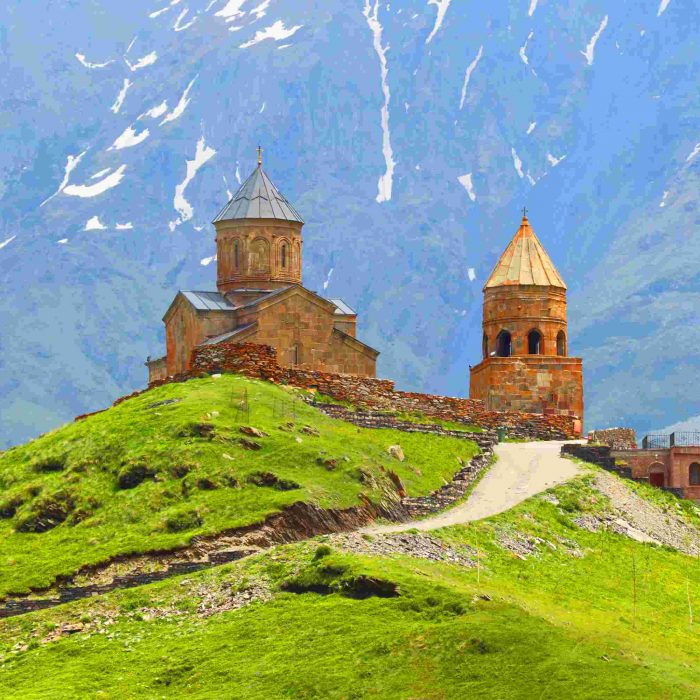Kurze Fakten über Ägypten:
- Einwohnerzahl: Ungefähr 104 Millionen Menschen.
- Hauptstadt: Kairo.
- Größte Stadt: Kairo.
- Offizielle Sprache: Arabisch.
- Andere Sprachen: Ägyptisch-Arabisch, Englisch und Französisch werden ebenfalls häufig gesprochen.
- Währung: Ägyptisches Pfund (EGP).
- Regierung: Einheitliche semipräsidentielle Republik.
- Wichtigste Religion: Islam, überwiegend sunnitisch.
- Geographie: Ägypten liegt in Nordafrika und grenzt im Norden an das Mittelmeer, im Nordosten an Israel und den Gaza-Streifen, im Osten an das Rote Meer, im Süden an den Sudan und im Westen an Libyen.
Fakt 1: Die ägyptischen Pyramiden sind das einzige erhaltene der 7 Weltwunder
Die ägyptischen Pyramiden, insbesondere die Große Pyramide von Gizeh, sind die einzigen noch erhaltenen Bauwerke der ursprünglichen Sieben Weltwunder der Antike. Die Große Pyramide wurde vor über 4 500 Jahren während der Herrschaft des Pharaos Cheops erbaut und ist ein Zeugnis altägyptischer Ingenieurskunst und monumentaler Architektur.
Die Sieben Weltwunder der Antike waren eine Liste bemerkenswerter Bauwerke aus der klassischen Ära, die von verschiedenen griechischen Schriftstellern zusammengestellt wurde. Diese Wunder wurden für ihre architektonischen und künstlerischen Leistungen gefeiert und spiegelten die kulturellen und technologischen Errungenschaften der jeweiligen Zivilisationen wider. Hier finden Sie einen kurzen Überblick über die einzelnen Bauwerke:
- Große Pyramide von Gizeh, Ägypten: Die älteste und größte der Pyramiden von Gizeh wurde um 2560 v. Chr. als Grabmal für den Pharao Cheops errichtet. Sie zeichnet sich durch ihre gewaltigen Ausmaße und ihre präzise Ausrichtung nach den Himmelsrichtungen aus.
- Hängende Gärten von Babylon, Irak: Beschrieben als eine terrassenförmige Gartenoase mit üppiger Vegetation, die angeblich von König Nebukadnezar II. um 600 v. Chr. erbaut wurde. Ihre Existenz und ihr Standort sind unter Historikern nach wie vor umstritten.
- Statue des Zeus in Olympia, Griechenland: Eine riesige sitzende Statue des Gottes Zeus, die der Bildhauer Phidias um 435 v. Chr. schuf. Sie befand sich im Zeustempel in Olympia, der für seine künstlerische Pracht bekannt war.
- Tempel der Artemis in Ephesus, Türkei: Ein großer griechischer Tempel, der der Göttin Artemis gewidmet ist und vor seiner endgültigen Zerstörung im Jahr 401 n. Chr. mehrmals umgebaut wurde. Er war bekannt für seine imposante Größe und seine kunstvollen Verzierungen.
- Mausoleum in Halikarnassos, Türkei: Ein monumentales Grabmal, das um 350 v. Chr. für Mausolus, einen Satrapen des persischen Reiches, und seine Frau Artemisia errichtet wurde. Es war mit komplizierten Skulpturen und Reliefs geschmückt.
- Koloss von Rhodos, Griechenland: Eine riesige Bronzestatue des Sonnengottes Helios, die um 280 v. Chr. im Hafen von Rhodos errichtet wurde. Mit einer Höhe von etwa 33 Metern war sie eine der höchsten Statuen der antiken Welt.
- Leuchtturm von Alexandria, Ägypten: Der auch als Pharos von Alexandria bekannte Leuchtturm wurde um 280 v. Chr. auf der Insel Pharos erbaut. Er diente als Leuchtfeuer für Seeleute, die in den geschäftigen Hafen von Alexandria einliefen, und wurde für seine innovative Konstruktion bewundert.
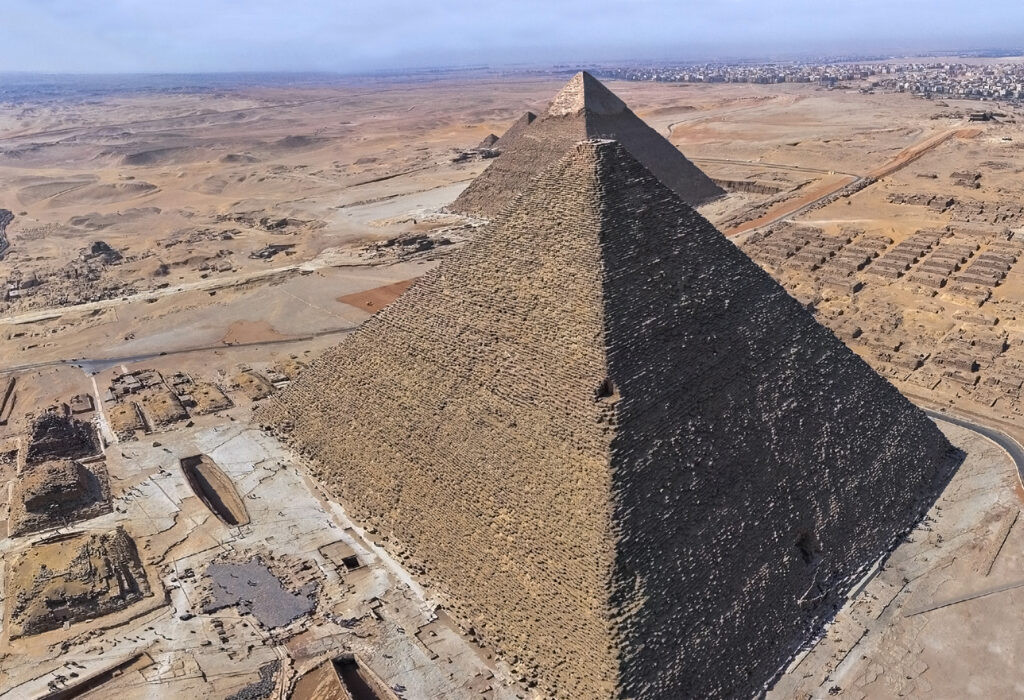
Fakt 2: Fast die gesamte Bevölkerung Ägyptens lebt in der Nähe des Nils
Der Nil ist nicht nur ein geografisches Merkmal, sondern auch eine Lebensader für Ägypten, die die Demografie und das tägliche Leben des Landes prägt. Fast die gesamte ägyptische Bevölkerung lebt an den fruchtbaren Ufern und im Delta des Nils. Diese Konzentration ist auf die einzigartige Fähigkeit des Flusses zurückzuführen, die Landwirtschaft durch seine jährlichen Überschwemmungen zu unterstützen, bei denen nährstoffreicher Schlamm im Niltal und -delta abgelagert wird. Auf diesen fruchtbaren Böden werden Pflanzen wie Weizen, Gerste und Baumwolle angebaut, die sowohl für den Lebensunterhalt als auch für den Export wichtig sind.
Neben der Landwirtschaft liefert der Nil in einer ansonsten trockenen Landschaft wichtiges Süßwasser zum Trinken, für die Bewässerung und für die industrielle Nutzung. Diese Abhängigkeit hat in der Vergangenheit die Siedlungsmuster und wirtschaftlichen Aktivitäten bestimmt und das Wachstum von Städten und Gemeinden entlang des Nils begünstigt. Städtische Zentren wie Kairo, Luxor und Assuan haben sich als Knotenpunkte für Handel, Kultur und Verwaltung entwickelt und sind durch Verkehrsnetze, die dem Flusslauf folgen, miteinander verbunden.
Fakt 3: Der Suezkanal in Ägypten ist eine wichtige Transportroute
Diese künstliche Wasserstraße, die 1869 fertiggestellt wurde, spielt eine zentrale Rolle im Welthandel, da sie die Reisezeit und die Entfernung für Schiffe zwischen dem Atlantik und dem Pazifik erheblich verkürzt.
Durch seine strategische Lage an der Schnittstelle zwischen Europa, Afrika und Asien ist der Suezkanal für die internationale Schifffahrt von entscheidender Bedeutung, da er es den Schiffen ermöglicht, die langwierige und gefährliche Fahrt um die Südspitze Afrikas, das Kap der Guten Hoffnung, zu vermeiden. Jährlich durchqueren Tausende von Frachtschiffen, Containerschiffen, Tankern und anderen Seeschiffen den Kanal und transportieren Waren von Rohöl und Erdgas bis hin zu Industrieprodukten und Rohstoffen.
Die Bedeutung des Kanals geht über kommerzielle Interessen hinaus und dient als Dreh- und Angelpunkt für die regionale Wirtschaft und die globalen Lieferketten. Er verschafft Ägypten beträchtliche Einnahmen durch Mautgebühren und unterstützt die damit verbundenen Industrien und die Entwicklung der Infrastruktur entlang seines Korridors. Darüber hinaus ist der Suezkanal aufgrund seiner strategischen Bedeutung zu einem Brennpunkt der internationalen Diplomatie und der Zusammenarbeit zwischen Nationen geworden, die auf seinen effizienten Betrieb angewiesen sind.
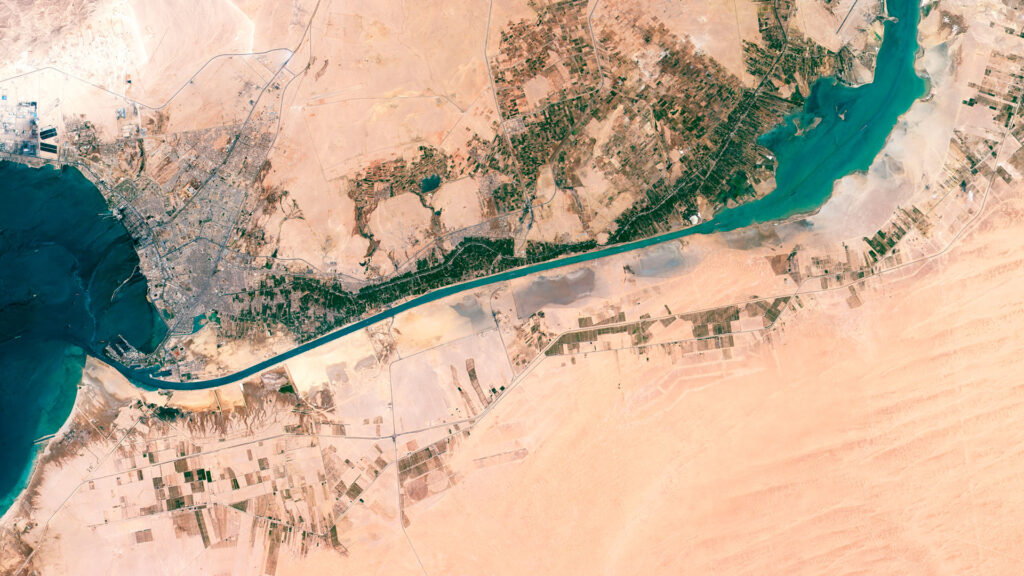
Fakt 4: Kleopatra war keine Ägypterin
Sie gehörte der ptolemäischen Dynastie an, die Ägypten nach dem Tod Alexanders des Großen regierte. Die Ptolemäer waren makedonisch-griechischer Herkunft und behielten ihre griechische Identität und Traditionen bei, obwohl sie über Ägypten herrschten.
Kleopatras Familie, einschließlich ihres Vaters Ptolemaios XII. Auletes und ihrer Vorgänger, stammte von Ptolemaios I. Soter ab, einem der Generäle Alexanders des Großen, der nach Alexanders Eroberungen Herrscher über Ägypten wurde. Während der gesamten ptolemäischen Periode sprach die herrschende Klasse in Ägypten, einschließlich der königlichen Familie und der Verwaltungsbeamten, überwiegend Griechisch und hielt sich an griechische Bräuche und Traditionen.
Trotz ihrer griechischen Abstammung machte sich Kleopat die ägyptische Kultur und den religiösen Glauben zu eigen, um ihre Position als Pharao von Ägypten zu stärken. Sie lernte die ägyptische Sprache und stellte sich selbst als Reinkarnation der ägyptischen Göttin Isis dar, was sie beim ägyptischen Volk beliebt machte. Kleopatras Bündnis mit Julius Cäsar und später mit Mark Anton war von entscheidender Bedeutung für die politischen und militärischen Kämpfe der Römischen Republik und des späteren Römischen Reiches.
Fakt 5: Ägypten hat eine große Anzahl historischer Monumente erhalten
Ägypten verfügt über eine beeindruckende Anzahl historischer Denkmäler, darunter über 100 Pyramiden, die über das ganze Land verstreut sind. Die berühmteste ist die Große Pyramide von Gizeh. Zu den antiken Tempeln entlang des Nils gehören gut erhaltene Stätten wie der Tempelkomplex von Karnak in Luxor, der sich über eine Fläche von etwa 200 Hektar erstreckt und zu den größten Tempelanlagen der Welt gehört. Außerdem beherbergt Ägypten zahlreiche Gräber im Tal der Könige, wo über 60 Gräber entdeckt wurden, darunter das berühmte Grab von Tutanchamun.
Die Erhaltung dieser Denkmäler ist eine monumentale Aufgabe, an der die ägyptischen Behörden und internationale Organisationen ständig arbeiten. Die Restaurierung und Erhaltung dieser antiken Bauwerke ist von entscheidender Bedeutung, um ihre Unversehrtheit zu bewahren und sicherzustellen, dass sie auch künftige Generationen über die reiche Geschichte und das kulturelle Erbe Ägyptens aufklären und inspirieren. Diese Bemühungen unterstützen auch die ägyptische Tourismusindustrie, die in hohem Maße auf Besucher angewiesen ist, die diese Wahrzeichen und archäologischen Stätten besuchen.
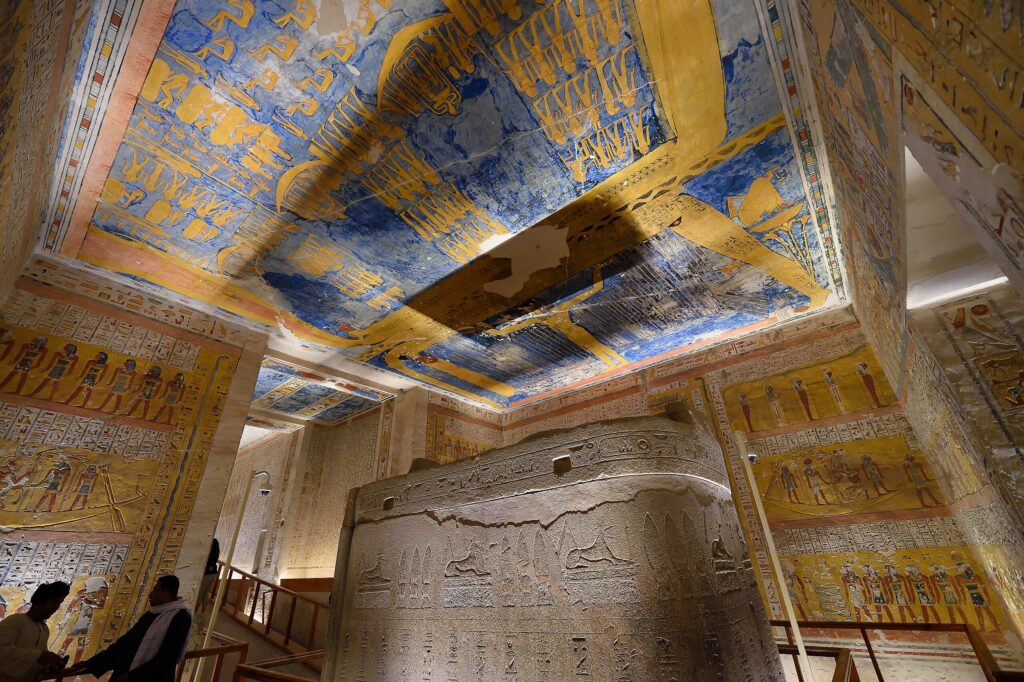
Fakt 6: Während der Kolonialzeit wurde eine große Anzahl von Artefakten aus Ägypten entwendet
In dieser Zeit, insbesondere ab dem 19. Jahrhundert, fanden umfangreiche Ausgrabungen und Sammlungen altägyptischer Artefakte durch europäische Archäologen, Sammler und Entdecker statt.
Der Zustrom ausländischer Archäologen und Schatzsucher wurde durch die Faszination für die altägyptische Kultur und den Wunsch, wertvolle Artefakte zu finden, angefacht. Viele dieser Artefakte, darunter Statuen, Töpferwaren, Schmuck und Sarkophage, wurden aus Ägypten mitgenommen und landeten in Museen und Privatsammlungen auf der ganzen Welt.
Das bekannteste Beispiel ist der Stein von Rosette, der 1799 von französischen Soldaten während des Feldzugs von Napoleon Bonaparte in Ägypten entdeckt wurde. Dieses Artefakt, das für die Entzifferung der altägyptischen Hieroglyphen von entscheidender Bedeutung war, wurde später vom British Museum in London erworben.
In den letzten Jahrzehnten hat sich Ägypten auf diplomatischem Wege und mit juristischen Mitteln um die Rückführung von geplünderten Artefakten bemüht und einige Objekte von internationalen Museen und Institutionen zurückerhalten.
Fakt 7: Die Ägypter hatten Tausende von Göttern
Die alten Ägypter hatten ein komplexes und vielfältiges Pantheon mit Tausenden von Göttern und Göttinnen, die verschiedene Aspekte des Lebens, der Natur und des Kosmos repräsentierten. Diese Gottheiten reichten von großen Göttern wie Ra, dem Sonnengott, und Osiris, dem Gott des Jenseits, bis hin zu kleineren Göttern, die mit bestimmten Funktionen oder lokalen Kulten verbunden waren. Jede Gottheit spielte in der ägyptischen Mythologie und den religiösen Praktiken eine besondere Rolle und beeinflusste das tägliche Leben, die Rituale und den Glauben.
Auch Katzen nahmen einen besonders wichtigen Platz in der altägyptischen Gesellschaft und Religion ein. Sie wurden wegen ihrer Anmut, ihrer Schönheit und ihrer vermeintlichen Schutzeigenschaften verehrt. Die Göttin Bastet, die oft als Löwin oder mit dem Kopf einer Hauskatze dargestellt wurde, war die Schutzherrin des Hauses, der Fruchtbarkeit und der Geburten. Katzen galten Bastet als heilig, und man glaubte, dass ihre Anwesenheit im Haushalt Segen bringen und böse Geister abwehren würde.
Die Bedeutung der Katzen ging über die religiöse Symbolik hinaus. Sie wurden als Beschützer der Ernten und Getreidespeicher geschätzt und hielten Nagetiere und Schädlinge fern.
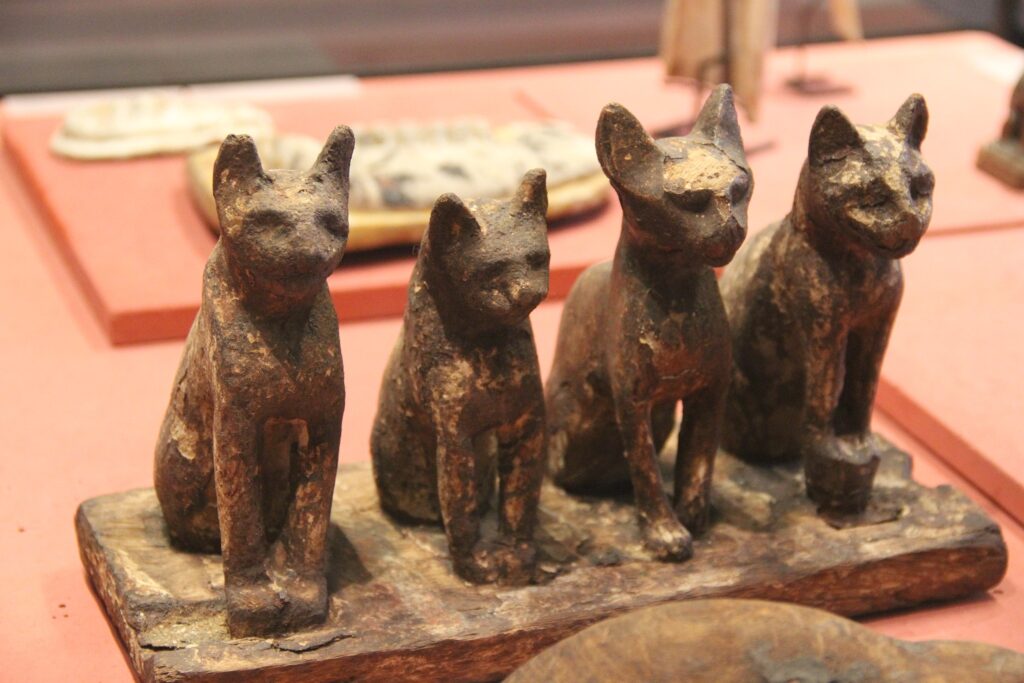
Fakt 8: Geografisch gesehen liegt Ägypten auf zwei Kontinenten
Geografisch gesehen liegt Ägypten im Nordosten Afrikas und erstreckt sich über die nordöstliche Ecke des afrikanischen Kontinents und die südwestliche Ecke des asiatischen Kontinents. Das Land wird im Norden durch das Mittelmeer, im Osten durch das Rote Meer, im Süden durch den Sudan und im Westen durch Libyen begrenzt. Die Sinai-Halbinsel im nordöstlichen Teil Ägyptens verbindet das afrikanische Festland mit dem asiatischen Kontinent.
Fakt 9: Ägypten hat 7 UNESCO-Welterbestätten
Ägypten beherbergt sieben UNESCO-Welterbestätten, die jeweils für ihre herausragende kulturelle oder natürliche Bedeutung anerkannt wurden. Zu diesen Stätten, die das vielfältige Erbe Ägyptens präsentieren, gehören:
- Das antike Theben mit seiner Nekropole (Luxor): Diese Stätte umfasst die Ruinen der antiken Stadt Theben (das heutige Luxor), darunter die Tempel von Karnak und Luxor, das Tal der Könige und das Tal der Königinnen.
- Historisches Kairo: Das Herz der ägyptischen Hauptstadt Kairo ist bekannt für seine islamische Architektur, darunter Moscheen, Madrasas und andere historische Gebäude.
- Abu Mena: Diese archäologische Stätte mit den Überresten eines koptisch-christlichen Klosterkomplexes und Pilgerzentrums befindet sich in der Nähe von Alexandria.
- Nubische Monumente von Abu Simbel bis Philae: Diese Stätte umfasst die Tempel von Abu Simbel, die von Ramses II. erbaut wurden, und die Tempel von Philae, die wegen des Baus des Assuan-Hochdamms verlegt wurden.
- Sankt-Katharina-Gebiet: Diese auf der Sinai-Halbinsel gelegene Stätte umfasst den Berg Sinai, auf dem der Überlieferung nach Moses die Zehn Gebote empfing, und das Katharinenkloster, eines der ältesten christlichen Klöster der Welt.
- Wadi Al-Hitan (Tal der Wale): Das Wadi Al-Hitan, ein Wüstengebiet südwestlich von Kairo, ist bekannt für seine versteinerten Überreste von ausgestorbenen Walen und anderen Meeresbewohnern und bietet Einblicke in die Evolution der Wale.
- Die antike Stadt Qalhat: Diese Stätte im Oman umfasst die Überreste einer antiken Stadt und eines Hafens, die zwischen dem 11. und 15. Jahrhundert ein wichtiger Handelsknotenpunkt mit starken kulturellen Verbindungen zu Ägypten waren.
Hinweis: Wenn Sie planen, das Land auf eigene Faust zu bereisen, prüfen Sie, ob Sie in Ägypten einen internationalen Führerschein benötigen, um ein Auto zu mieten und zu fahren.
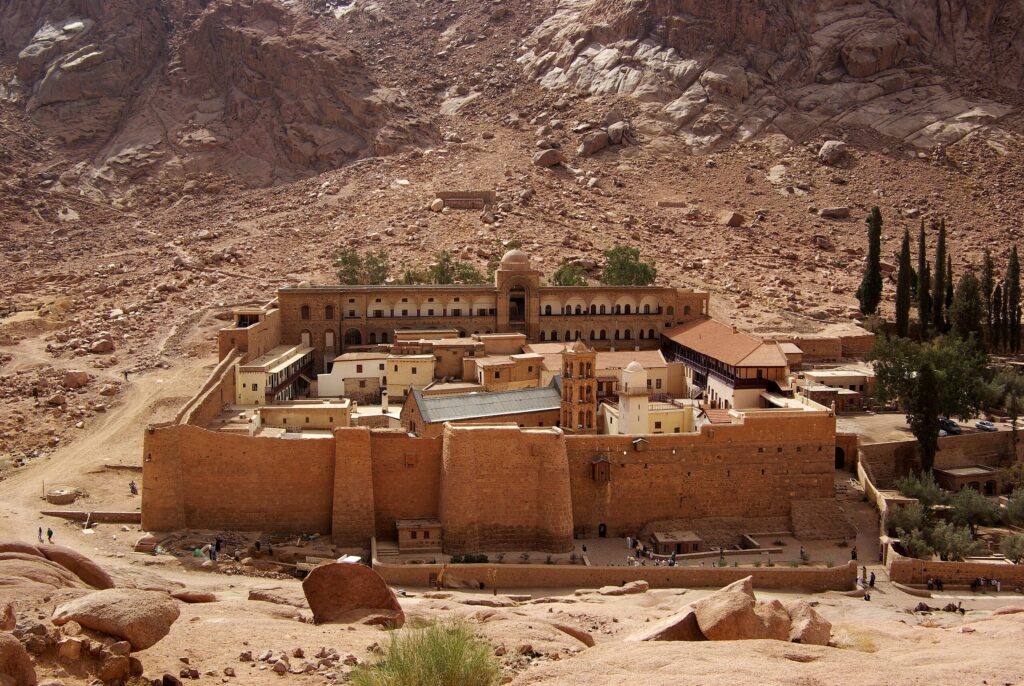
Fakt 10: Ägyptens Bevölkerungsstruktur veränderte sich nach der arabischen Eroberung dramatisch
Die arabische Eroberung Ägyptens im 7. Jahrhundert n. Chr. brachte bedeutende demografische und kulturelle Veränderungen mit sich. Arabische Siedler und Soldaten wanderten nach Ägypten ein, was zur Verbreitung der arabischen Sprache, des islamischen Glaubens und der kulturellen Praktiken führte. Städtische Zentren wie Kairo blühten als Zentren des Handels und der islamischen Bildung auf. Trotz dieser Veränderungen bewahrten die einheimischen ägyptischen Gemeinschaften, wie z. B. die koptischen Christen, ihre kulturellen und religiösen Identitäten neben den neuen arabisch-islamischen Einflüssen. In dieser Zeit wurde der Grundstein für das vielfältige kulturelle Erbe und die moderne Identität Ägyptens gelegt.

Veröffentlicht Juni 30, 2024 • 11 m zum Lesen

